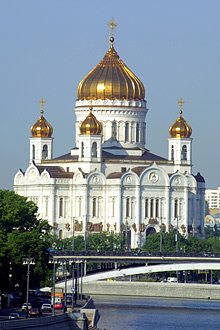 |
 One of the most imposing and controversial buildings in Russia, the resurrected Cathedral of Christ the Saviour has had a short but turbulent history. It was originally commissioned after the defeat of Napoleon, but work did not begin on its construction until 1839. Designed by the great St. Petersburg architect Konstantin Ton, who was also responsible for the Grand Kremlin Palace and the Kremlin Armoury and whose church designs pioneered the Byzantine-revival style, the cathedral was erected, for maximum effect, on the embankment only a few minutes' walk from the Kremlin. Sadly, this entailed the destruction of the medieval Alekseevskiy Convent, a course of events which lends an intriguing irony to the cathedral's own fate.
One of the most imposing and controversial buildings in Russia, the resurrected Cathedral of Christ the Saviour has had a short but turbulent history. It was originally commissioned after the defeat of Napoleon, but work did not begin on its construction until 1839. Designed by the great St. Petersburg architect Konstantin Ton, who was also responsible for the Grand Kremlin Palace and the Kremlin Armoury and whose church designs pioneered the Byzantine-revival style, the cathedral was erected, for maximum effect, on the embankment only a few minutes' walk from the Kremlin. Sadly, this entailed the destruction of the medieval Alekseevskiy Convent, a course of events which lends an intriguing irony to the cathedral's own fate.
The enormous - and extremely expensive - cathedral was eventually consecrated in 1883, and its vast copper domes dominated the Moscow skyline. However, the cathedral had taken almost as much time to build and to decorate as it would remain standing in its original incarnation. For fairly obvious reasons, it was singled out by the Soviet government for destruction and, in 1931, blown to pieces to make way for a proposed Palace of Soviets, one of the most influential pieces of architecture never to be built. The design approved by Stalin would have stood over 400 meters high, with a vast statue of Lenin at its peak, and, although it was never built, the blueprint was nonetheless the forefather of the Seven Sisters, the magnificent Stalinist skyscrapers that lower over central Moscow. Only the foundations had been laid when the Second World War brought an abrupt end to such an ambitious project, and Stalin's successor, Nikita Khruschev, had no stomach for such grandiose displays of hubris. The project was abandoned, and the site turned over to become an open-air swimming pool, the largest in the world, which was kept at a temperature of 27°C all year round. The result was a thick covering of fog that shrouded a number of gruesome deaths (and murders) among the swimmers.
The symbolic significance of the site was reaffirmed after the fall of the Soviet Union, when ambitious Moscow Mayor Yuri Luzhkov joined forces with the Orthodox Church to resurrect the cathedral in a $360-million reconstruction project. Completed in 2000, the new cathedral is loosely based on Ton's original designs, but constructed with modern building materials and fitted out with all mod-cons including air conditioning, telecommunications facilities, elevators and underground parking. Visitors can only see the cathedral as part of an organized tour, one of the highlights of which is the panoramic view from the 40-meter-high observation platform.
|
 |

 One of the most imposing and controversial buildings in Russia, the resurrected Cathedral of Christ the Saviour has had a short but turbulent history. It was originally commissioned after the defeat of Napoleon, but work did not begin on its construction until 1839. Designed by the great St. Petersburg architect Konstantin Ton, who was also responsible for the Grand Kremlin Palace and the Kremlin Armoury and whose church designs pioneered the Byzantine-revival style, the cathedral was erected, for maximum effect, on the embankment only a few minutes' walk from the Kremlin. Sadly, this entailed the destruction of the medieval Alekseevskiy Convent, a course of events which lends an intriguing irony to the cathedral's own fate.
One of the most imposing and controversial buildings in Russia, the resurrected Cathedral of Christ the Saviour has had a short but turbulent history. It was originally commissioned after the defeat of Napoleon, but work did not begin on its construction until 1839. Designed by the great St. Petersburg architect Konstantin Ton, who was also responsible for the Grand Kremlin Palace and the Kremlin Armoury and whose church designs pioneered the Byzantine-revival style, the cathedral was erected, for maximum effect, on the embankment only a few minutes' walk from the Kremlin. Sadly, this entailed the destruction of the medieval Alekseevskiy Convent, a course of events which lends an intriguing irony to the cathedral's own fate.